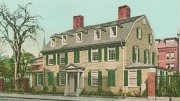1935
After the Harvard Athletic Association asks alumni to help underwrite the cost of American participation in the coming Berlin Olympics, Maxwell Steinhardt ’11 writes the editors condemning this endorsement as “contrary to our ideals of fair play and equality for all….Our traditions demand that we do not participate in these games….so that Germany will understand that this nation, at least, does not subscribe to her policies.”
* * *
President Conant terms it “almost miraculous” that the class of 1910 has raised $100,000 for its twenty-fifth reunion.
1950
Harvard hosts the first International Congress of Mathematicians since 1936. Besides arcane discussions there are 10 social events, including a “Memorial Hall beer party at which blackboards were supplied so that the guests would have profundity with their pretzels.” The Soviet Academy of Science declares its mathematicians are “too busy to attend.”
1955
The University will implement a comprehensive health plan for its 10,000 students in the fall, providing complete medical service for a single fee of $56.50.
* * *
To meet the cost of screening increased numbers of applicants (4,000 in 1954-55), the College announces that it will adopt, “with great reluctance,” a $10 admission application fee beginning next year.
1965
To the delight of supporters and chagrin of detractors, brand-new Peabody Terrace--designed by the firm of Josep Lluis Sert, dean of the School of Design--receives a First Honor Award from the American Institute of Architects.
1975
On July 1, the Harvard and Radcliffe admissions offices are consolidated, making the class of 1979 the last chosen by separate committees. “From now on, applicants will be reviewed on an ‘equal-access’ basis”--without regard to the male-female proportions of the class.
1980
The Medical Area Total Energy Plant (MATEP), intended as an energy saver for the Longwood area, opens for operation, “easily the most expensive project ever launched by a university,” and riddled with problems from “angry neighbors, lengthy regulatory delays, and a multimillion-dollar overrun in construction costs.”








